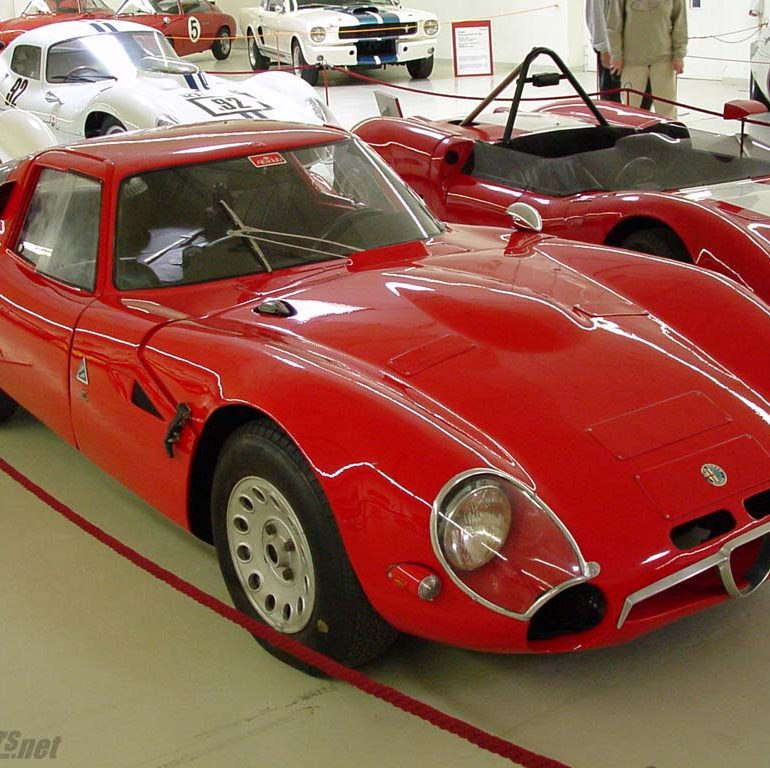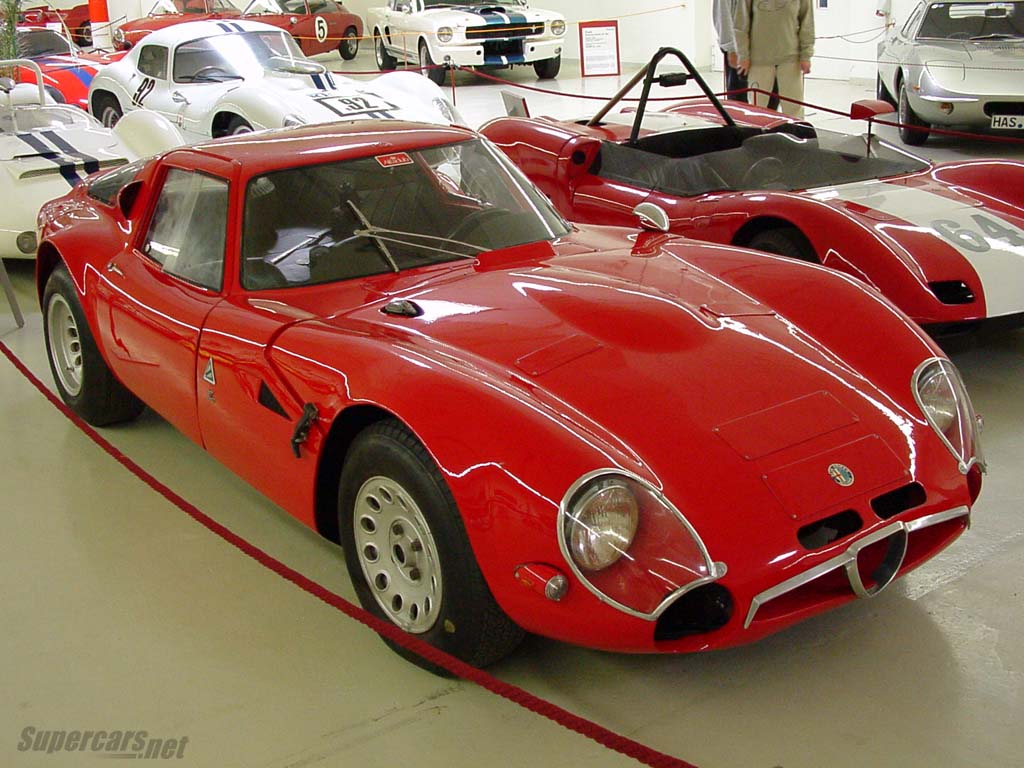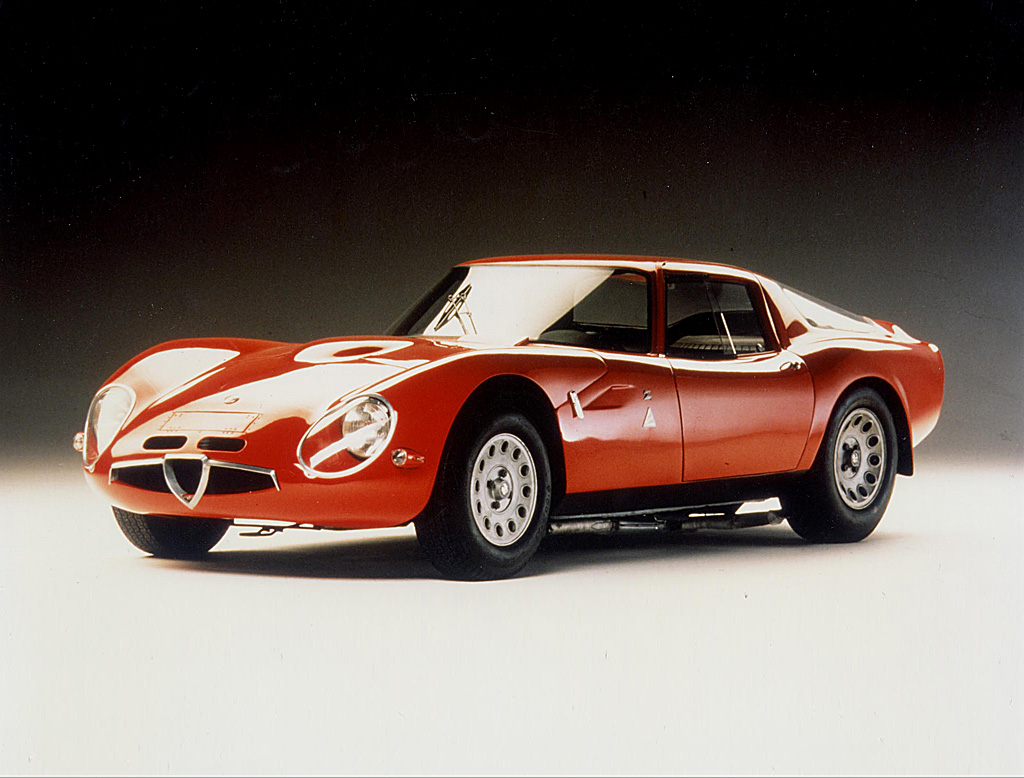1965 Alfa Romeo Giulia TZ2
Built at Carlo Chiti’s Autodelta, the TZ2 benefited from the engineer’s experience as well as a strong relationship with Alfa Romeo and it’s president Giuseppi Luraghi. Encouraged by the sucess of the TZ1, also built by Autodelta, Alfa Romeo purchased the firm to take over its competition wing.
The newely reformed Autodelta became responsible for all of Alfa Romeo’s race development and team management. One of their first jobs was upgrade the TZ1, a lightwight, spaceframe race car, into a more lighter, lower and more powerful machine for factory racing. So the team at Autodelta, which included Carlo Chiti, Oarzio Satta and Guisseppe Busso, took the TZ1 and transformed it into what many have called a ‘mini Ferrari GTO’.
Since Autodelta didn’t need to supply TZ2s to privateer teams and meet homogation production requirements, they were freer to try new ideas and spend more money in the name of performance. The main difference between the TZ1 and TZ2 was the use of glass reinforced plastic (GRP) for the body which Porsche had made successful on the 904 Carrera GTS. This body replaced the old aluminum design and helped shed off nearly 100kg off the orginal TZ. Despite the fact that most cars were built off same moulds taken from the prototype TZ2, many differed in detail, especially with regard to the front fascia and venting.
Compared to the TZ1, the new TZ2’s body was both lower and more purposeful. It was the work of Ercole Spada from the Zagato design house in Milan. Spada’s TZ sat just 41 inches tall which was partly due to the new fully adjustable suspension mounted lower in the chassis. Ride height aside, the body was a treat to the eye and not totally unlike the Ferrari GTO, both having cut-off Kamm tails, covered headlights and bulbous fenders.
All TZ2 engines were prepared by Virgilio Conrero’s Autotecnica Conrero shop in Torino. They took Alfa’s DOHC Inline-4 four, gave it ultra-light magnesium casings and the cylinder head from the GTA. Together with hotter camshafts, larger valves and twin-plug ignition, the unit produced 170bhp at 7500rpm which was good for 160 mph! The engine also received a dry sump lubrication system, so it could sit lower in the chassis without impeding ground clearance.
Chassis manufacture was sub-contracted to Ambrosini and Chief Designer Busso fitted new 13-inch diameter Campagnolo wheels to replace TZ1’s 15-inch units.
Inside, the steeply raked windscreen limited space so reclining seats were fitted and the steering column was lowered as well as the entire dashboard. Since the transmission tunnel sat so much higher in the TZ2, the length of the gearshift was substantially lowered.
The racing career of the TZ2, while brief, was very successful. In 1966 the car ran in five international events, of which it took first class every time. Autodelta did take a stab at LeMans in 1965, but none of the three cars managed to finish.
Due to their high cost, only 12 to 14 original TZ2s were manufactured. Many of the old TZ1 cars were upgraded which further complicates the issue of just how many TZ2s were created. Two particularly interesting chassis were sent to Bertone and Pininfarina to flirt with the idea of what a road going version might look like. The Canguro by Bertone was a magnificent piece, but far to expensive to produce.
After 18 months of dominating the 1.6-litre GT class, Alfa Romeo switched from the declining GT Class and had Autodelta focus on a rear-engine prototype. Infact, the very one was powered by a TZ2 engine and marked the start of the Tipo 33.
Story by Richard Owen for Supercars.net
In Detail
| submitted by | Richard Owen |
| engineers | Carlo Chiti |
| engine | Aluminum AlloyInline-4 w/Dry Sump Lubrication |
| position | Front Longitudinal |
| aspiration | Natural |
| valvetrain | DOHC, 2 Valves per Cyl |
| fuel feed | 2 Weber 45 DCOE 14 Carburetors |
| displacement | 1570 cc / 95.8 in³ |
| bore | 78 mm / 3.07 in |
| stroke | 82 mm / 3.23 in |
| compression | 11.4:1 |
| power | 126.8 kw / 170 bhp @ 7500 rpm |
| specific output | 108.28 bhp per litre |
| bhp/weight | 269.84 bhp per tonne |
| body / frame | Fibreglass over Tubular Steel Chassis |
| driven wheels | RWD |
| wheel type | Cast Campagnolo |
| front brakes | Discs |
| rear brakes | Discs |
| steering | Recirculating Ball |
| f suspension | Wishbones w/Telescopic Dampers, Coil Springs, Anti-Roll Bar |
| curb weight | 630 kg / 1389 lbs |
| wheelbase | 2200 mm / 86.6 in |
| front track | 1300 mm / 51.2 in |
| rear track | 1330 mm / 52.4 in |
| length | 3680 mm / 144.9 in |
| width | 1600 mm / 63.0 in |
| height | 1020 mm / 40.2 in |
| transmission | 5-Speed Manual |
| top speed | ~257.5 kph / 160 mph |
| designers | Ercole Spada, Carlo Chiti |






